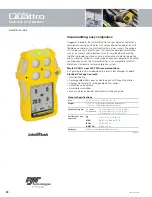
7
The sensor should be installed in rooms where the installed equipment may be a source of danger. This does not exclude
the possibility of installing additional sensors e.g. in corridors, bedrooms etc.
When choosing the place of installation of the device, make sure that the audible alarm will be well heard from other rooms.
It is recommended to install the detector on each floor of a multi-storey house.
1. Attach the unit to a wall 2~4m measured horizontally from the gas stove or natural gas emission source.
2. Vertical installation - 0.3 metres from the ceiling.
Mounting of the device:
1. Choose a suitable wall or other place, according to the above recommendations.
2. Fix the mounting frame using M5 or M3 screw (as shown in the picture above, two optional screw types
5 and
3), and then fix
the device to it.
IMPORTANT:
Places where you should not install the detector:
- in close proximity to windows, doors, ventilation ducts or entrances exposed to strong gusts of wind,
- in places with high humidity, dustiness,
- in dusty and smoky rooms,
- in places exposed to high temperatures as a result of furnace operation,
- in places where the device would be covered by other elements (behind furniture or curtains).
WARNING:
The detector only signals the danger after it has been installed.
OPERATION OF THE DEVICE
1. Connect the device to the network ~230V/50Hz.
2. If you want to connect a ventilator, electromagnetic valve etc. to the relay, do this first.
3. After connecting, the green POWER LED will light up and the yellow W-UP LED will heat up the sensor. The sensor will remain
in the non-ready state for another 3 minutes. During this time, the sensor will be warmed up. When the sensor is completely warmed
up, the yellow W-UP diode will go out and the device will be ready for use.
4. If the ambient gas concentration equals or exceeds the programmed level, the unit will change into alarm condition. The red
ALARM LED will then light up and a signal will sound. At the same time, the alarm signal will activate the relay or the valve.
5. When the ambient gas concentration is reduced below the pre-programmed level, the detector's alarm will be automatically
disabled
together
with
the
optionally
connected devices.
The detector
will
return
to
its
operating
state.
6. If the yellow ERROR LED on the sensor lights up, it means that the device is not working properly or is defective. In such cases,
please contact your supplier.
NOTE: Do not press the TEST button while preparing the device for operation (start-up).
The TEST button is used to test, check the device for proper operation.
TEST DEVICE - Test the unit regularly once a week.
1. Frequent testing of the device is required to check that the alarm power supply is correct and that the alarm is working properly.
2. Press the TEST button.
3. The device will sound a signal.
4. When testing the device, make sure that the sound is well audible in all rooms.
5. Never use open fire to test the device.
6. Never place the device close to your ears during detection or testing, as this may damage your hearing.






























